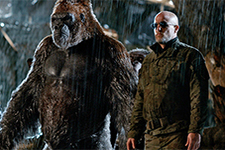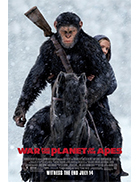War for the Planet of the Apes
|  If one were to look at the three films that comprise the Planet of the Apes rebooted prequel trilogy—Rise of the Planet of the Apes (2011), Dawn of the Planet of the Apes (2014), and now War for the Planet of the Apes—their dominant thematic trend is clearly the collapse of humanity. And by that I don’t just mean the literal wiping out of humankind by dominant apes (which we know is the ultimate result anyway), but rather the gradual breaking down of human decency, kindness, understanding, and respect for difference—the things that make humanity humane—which is why the trilogy has unwittingly become a perfect reflection of the social and political callousness of the Trump era. Rise centered on a number of sympathetic human characters, notably James Franco’s Will Rodman, whose scientific experiments in search of a cure for Alzheimer’s result in the creation of apes with advanced human intelligence, and Dawn also featured several decent human characters who sought to work with the apes for their mutual benefit. War pretty much dispenses with the idea than human beings are capable of anything outside of aggression and violence and hatred—all in the name of “survival,” of course, but isn’t that always a convenient excuse to let our worst instincts run rampant? Nothing brings out the worst in us more than the existence of an enemy, real or otherwise. The screenplay by returning screenwriter Mark Bomback (The Wolverine, Insurgent) and director Matt Reeves (Cloverfield, Let Me In), who also helmed Dawn, resumes where the earlier film left off, with a small group of humans who have survived the simian flu that wiped out most of the Earth’s population, waging war against a race of intelligent apes. It is telling that the only human characters in the film are soldiers, the last remnants of the U.S. Army who have been reorganized into a rogue faction known as Alpha-Omega under the command of the vicious Colonel (Woody Harrelson), a dictatorial leader who wants nothing other than to wipe out the apes, which he sees as a threat to humanity’s superiority. The apes, who are led by the usually benevolent Caesar (Andy Serkis), are hiding in the forest trying to maintain their own civilization while the humans hunt them. The first shot of the film follows a group of soldiers as they creep through the forest, their helmets adorned with slogans like “Monkey Killer.” There are no illusions about compromise or co-existence; as the title suggests, this is war. Most of the action is centered around the human’s command post, which is constructed in a former weapons depot and has the general appearance of a Soviet-era gulag. Since virtually all of the human characters have resorted to a violence-at-all-costs ethos (with the sole exception of a young mute girl played by Amiah Miller, whom the apes adopt), the film’s moral entanglements reside almost entirely within Caesar, who is pushed to his limits when the Colonel slaughters his wife and child, sending him into a rage of vengeance that sees him for the first time losing sight of his place as leader and instead embracing vigilantism. Andy Serkis, who has played the character in all three films via motion capture, gives Caesar a fascinating sense of moral conflict, and the digital artistry that enhances Serkis’s performance has only gotten better. Those who have seen all the films in the trilogy will certainly find it difficult to watch Caesar, usually the voice of reason, breaking from his normal moral commitments in order to pursue a path of vengeance. This moral shift gives War for the Planet of the Apes a particularly dour tone, which is reflected in the wintry environment and grim cinematography by Michael Seresin (a favorite of Alan Parker’s who also shot Dawn). The loss of conflict within the human characters takes a toll, as War, despite the emotional engagement with Caesar’s moral and emotional conflict, lacks Dawn’s multifaceted interplay of politics and genuine emotional connection among human and ape characters. Here, they’re just pretty much at each other’s throats from the first frame to the last, with no possible outcome other than the complete obliteration of humanity so that the series can finally declare that Earth has become a planet of the apes. Copyright © 2017 James Kendrick Thoughts? E-mail James Kendrick All images copyright © 20th Century Fox |
Overall Rating: 

 (3)
(3)


